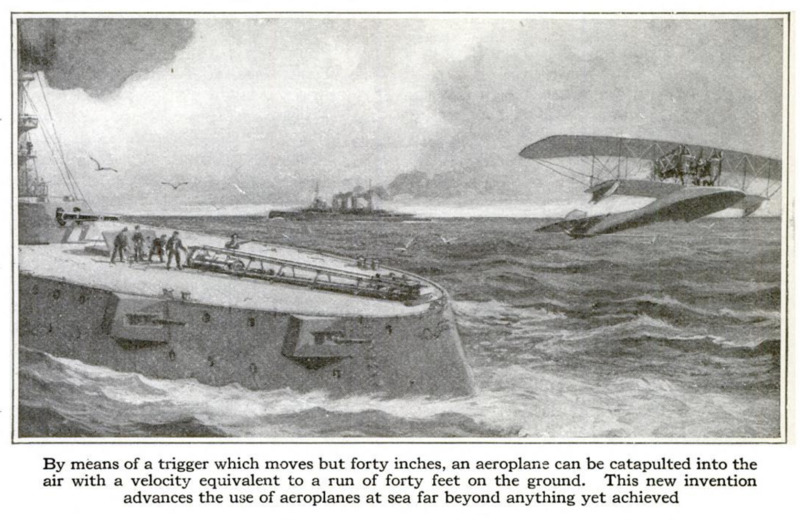Catapulting Seaplanes from Battleships
Item
-
Title (Dublin Core)
-
Catapulting Seaplanes from Battleships
-
Article Title and/or Image Caption (Dublin Core)
-
Catapulting Seaplanes from Battleships
-
Caption: By means of a trigger which moves but forty inches, an aeroplane can be catapulted into the air with a velocity equivalent to a run of forty feet on the ground. This new invention advances the use of aeroplanes at sea far beyond anything yet achived.
-
extracted text (Extract Text)
-
A FEW years ago, when the thought
of using aeroplanes in connection
with battleships occurred to naval
officers, the problem of launching was
solved in a crude way by means of
temporary inclined platforms built on
the deck. Apart from the military
objection to such a structure, the
weather conditions had to be decidedly
favorable in order to insure a successful
start for a flight. At no time was it
considered practicable to launch the
flying machine while the ship was in
motion. The machine ran down on the
platform on the regulation wheels of a
land machine; they were not real sea-
planes.
It was apparent that the hydro-
aeroplane or seaplane would have to be
carried temporarily upon a car or truck
from which it could be detached at the
right moment and allowed to rise of its
own impulse by reason of the supporting
pressure of the air due to the speed
acquired in a short run. It was also
clear that the car would have to be
quickly accelerated to full speed within a
run of something like forty feet. This
rapidly gathered headway had to be
insured without jerks or jars. To this
end Captain Washington I. Chambers
of our navy has devised a compressed-air
catapult, the compressed air operating a
piston which, in its turn, actuates a
wire rope traveling over pulleys. A
movement of but forty inches on the
part of the piston is multiplied so as
to draw the car forward forty feet.
To-day, the catapult has been so far
perfected by the Bureau of Construction
and Repair of the Navy Department
that it has become a permanent feature
aboard the aviation ship U.S.S. North
Carolina. Tt is now possible to launch
in flight the service seaplanes while the
cruiser is steaming along at fair speed.
The seaplane’s motor is set going be-
fore the catapulting process is started.
In fact, the pilot does not give the signal
for launching until his engine is working
just right. The impulse air for working
the piston is drawn right from the torpedo
air-supply system, and the working pres-
sure is something like three hundred
pounds to the square inch. By means of
a cleverly designed valve the air is ad-
mitted progressively to the cylinder, and
in this way the desired maximum speed
is reached from zero without So
In the future, our navy, when hundreds
of miles from shore; will be able to send
its seaplanes skyward with measurable
indifference to the weather.
-
Language (Dublin Core)
-
eng
-
Date Issued (Dublin Core)
-
1916-05
-
pages (Bibliographic Ontology)
-
713
-
Rights (Dublin Core)
-
Public Domain (Google digitized)
-
Archived by (Dublin Core)
-
Filippo Valle
-
Alberto Bordignon (Supervisor)
 Popular Science Monthly, v. 88, n. 5, 1916
Popular Science Monthly, v. 88, n. 5, 1916



